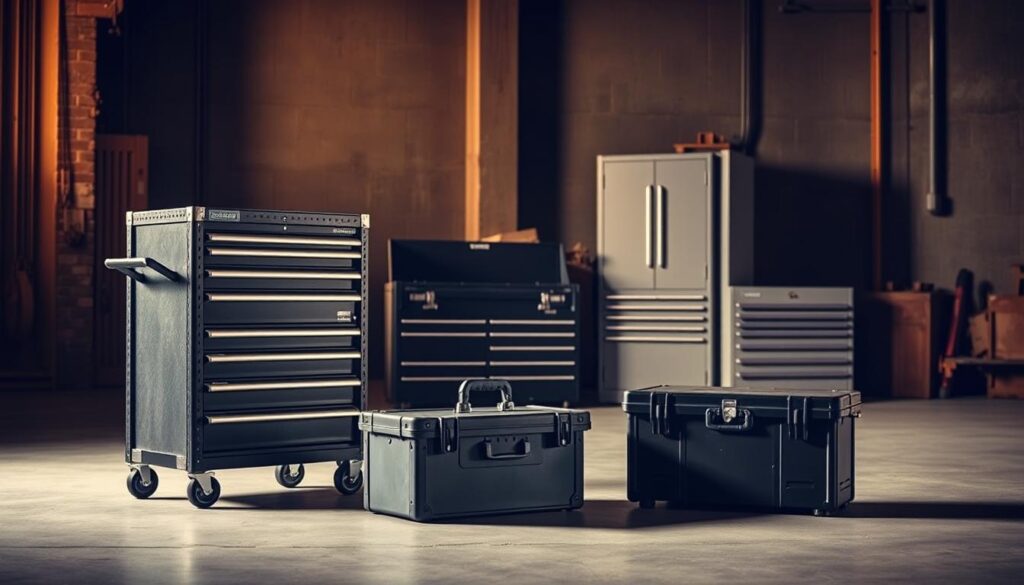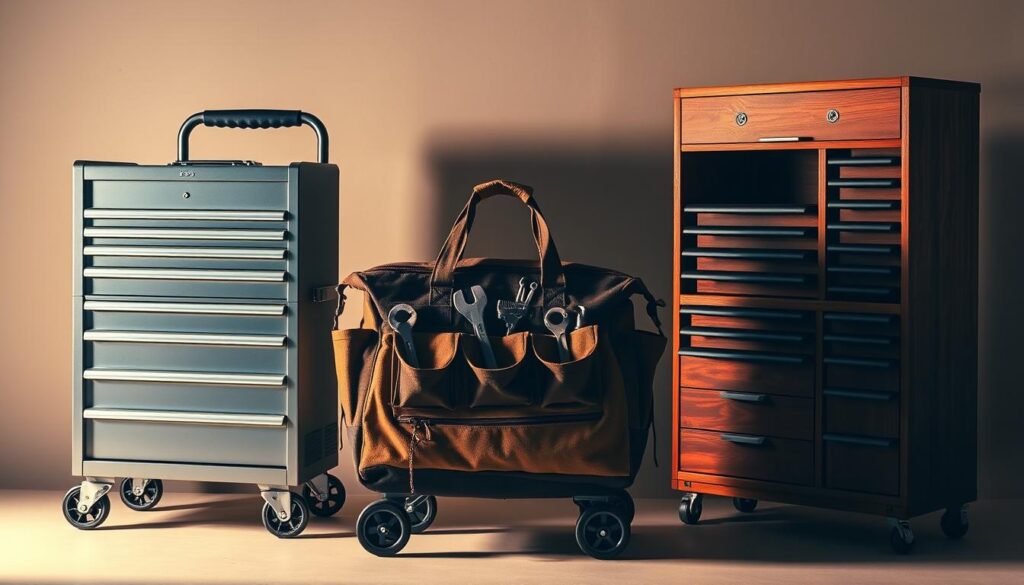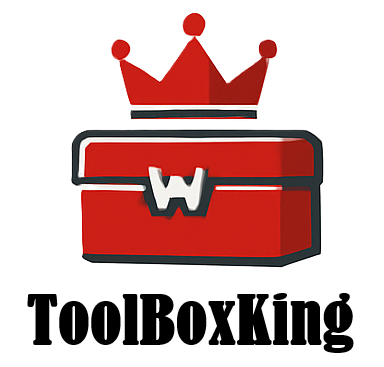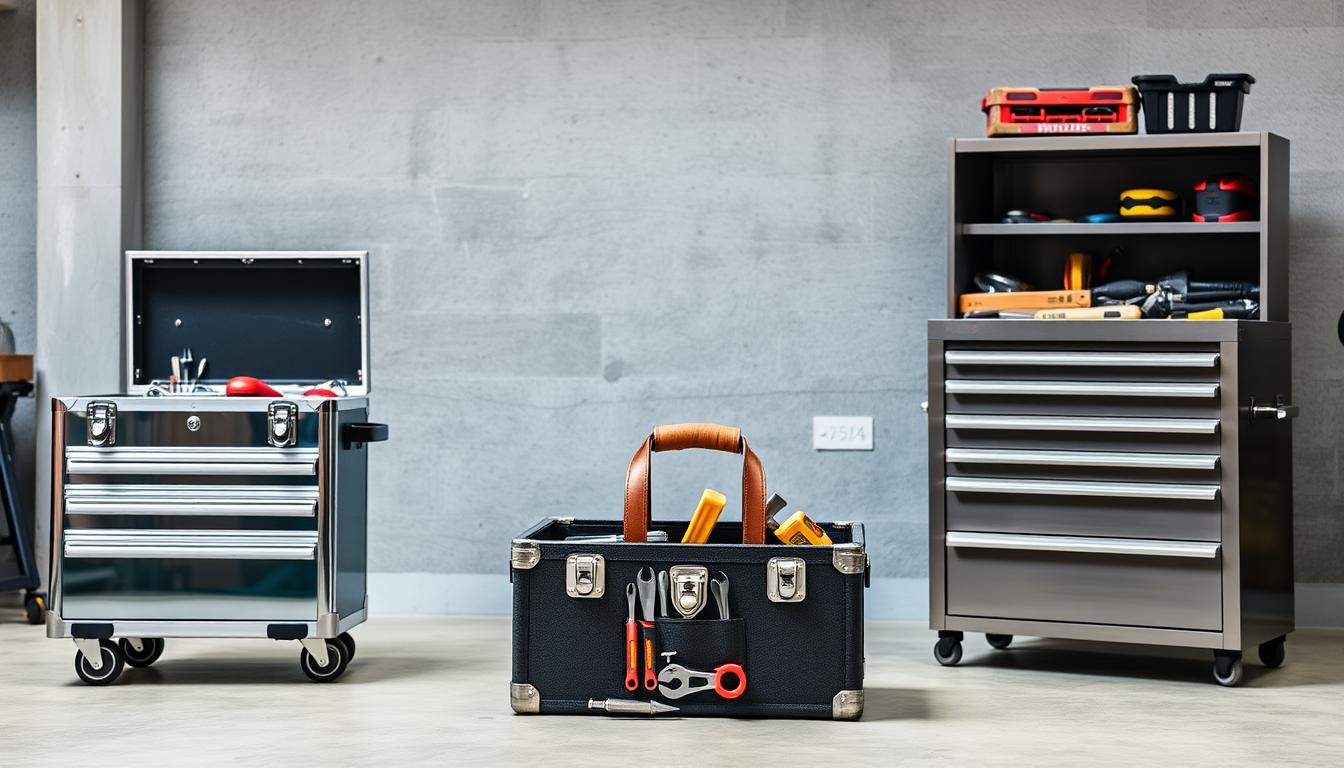Choosing the Right Tool Box: Rolling, Portable, or Stationary
Selecting the appropriate tool storage solution is crucial for any professional or DIY enthusiast. A well-built and secure storage container not only protects your tools but also enhances workflow efficiency.
The type of tool box you choose, whether it’s designed for mobility or fixed in one place, significantly impacts your ability to organize and access your tools. A sturdy tool box is an investment that requires careful consideration to ensure it meets your specific needs.
Key Takeaways
- Selecting the right tool box is crucial for tool organization and accessibility.
- A well-built tool box enhances workflow efficiency.
- The type of tool box chosen impacts tool storage and retrieval.
- Careful consideration is necessary when choosing a tool box.
- A good tool box is a valuable investment for professionals and DIY enthusiasts.
Understanding Tool Box Types and Their Importance
The world of tool storage has undergone significant transformations, leading to a diverse range of tool boxes. This evolution has been driven by the need for efficient tool organization and protection. As a result, various types of tool boxes have emerged, each designed to cater to different needs and preferences.
Tool boxes are no longer just simple containers; they are now sophisticated storage solutions that play a crucial role in maintaining tool organization, enhancing efficiency, and protecting tools against damage or loss.
The Evolution of Tool Storage Solutions
The evolution of tool storage solutions has been remarkable, with advancements in materials and design leading to the development of various tool box types. From simple wooden chests to complex modular systems, tool boxes have adapted to the changing needs of professionals and DIY enthusiasts alike.

| Tool Box Type | Key Features | Benefits |
|---|---|---|
| Rolling Tool Boxes | Wheeled mobility, durable construction | Ease of movement, high capacity |
| Portable Tool Boxes | Lightweight, compact design | Easy to carry, convenient storage |
| Stationary Tool Boxes | Fixed location, high storage capacity | Permanent storage, organization |
Why the Right Tool Box Matters for Efficiency and Tool Protection
Choosing the best tool box type is crucial for maintaining tool organization and protecting tools against damage. The right tool box can enhance efficiency by providing easy access to tools, reducing downtime, and preventing tool loss.
A well-chosen tool box also protects tools from environmental factors such as moisture, dust, and extreme temperatures, thereby extending their lifespan.
Rolling vs. Portable vs. Stationary: Which Tool Box Type Is Best for You?
Understanding the differences between rolling, portable, and stationary tool boxes is essential for making an informed decision that meets your specific needs.
Key Differences at a Glance
The primary distinctions between rolling, portable, and stationary tool boxes lie in their design, mobility, and storage capacity.
Rolling tool boxes are characterized by their wheeled bases, allowing for easy movement around workshops or job sites.
Portable tool boxes are designed for carrying by hand, offering flexibility and convenience for smaller tasks.
Stationary tool boxes, on the other hand, are fixed in place, providing substantial storage for a wide range of tools and equipment.

Mobility vs. Capacity Trade-offs
When choosing a tool box, there’s often a trade-off between mobility and storage capacity.
Rolling tool boxes strike a balance between the two, offering considerable storage while still being mobile.
Portable tool boxes prioritize mobility but typically have limited storage capacity.
Stationary tool boxes maximize storage capacity but are immobile.
Matching Tool Box Types to Your Specific Needs
The right tool box for you depends on your specific requirements, including the type of work you do, the tools you need to store, and your workspace constraints.
- For those who need to move around frequently, rolling or portable tool boxes might be more suitable.
- For workshops or garages where tools are used extensively, stationary tool boxes could be the better choice.
Deep Dive: Rolling Tool Boxes
For professionals on the move, the right tool box can make all the difference. Rolling tool boxes have become an essential asset for many tradespeople due to their mobility and versatility.
Design Features and Capabilities
Rolling tool boxes are designed with mobility in mind, featuring sturdy wheels that can withstand heavy loads and rough terrain. They often come with multiple compartments and drawers, allowing for organized storage of various tools and equipment.
Key design features include durable construction, ergonomic handles, and secure locking mechanisms to protect valuable tools during transport.
Advantages of Wheeled Mobility
The primary advantage of rolling tool boxes is their ease of mobility. Professionals can effortlessly move their tools around job sites or between workshops, saving time and reducing strain.
This mobility is particularly beneficial for large or heavy tool collections, as it eliminates the need for manual lifting or multiple trips.
Limitations and Considerations
While rolling tool boxes offer many benefits, there are some limitations to consider. For instance, they may not be suitable for extremely rough or uneven surfaces, and their mobility can be hindered by stairs or tight spaces.
Popular Rolling Tool Box Configurations
Two popular configurations of rolling tool boxes are roller cabinets and rolling workstations.
Roller Cabinets
Roller cabinets are designed for maximum storage capacity, often featuring multiple drawers and compartments. They are ideal for professionals with extensive tool collections.
Rolling Workstations
Rolling workstations combine storage with a work surface, providing a versatile solution for professionals who need to work on-site. They often feature integrated vice systems and other ergonomic design elements.
Deep Dive: Portable Tool Boxes
In the realm of tool storage, portable tool boxes stand out for their convenience and adaptability. These tool boxes are designed to be lightweight and easy to carry, making them ideal for professionals and DIY enthusiasts who need to transport their tools to various job sites.
Design Features and Carry Options
Portable tool boxes come with a variety of design features that enhance their portability. Many models include comfortable handles, while others offer shoulder straps or backpack-style carrying options for added convenience. The materials used are typically durable yet lightweight, ensuring that the tool box can withstand regular use without being too cumbersome.
Advantages of Lightweight Portability
The primary benefit of portable tool boxes is their ability to be easily moved from one location to another. This mobility is crucial for professionals who work on multiple sites or for homeowners who need to tackle projects in different areas. The lightweight nature of these tool boxes also means that users can carry a comprehensive set of tools without experiencing undue fatigue.
Limitations and Considerations
While portable tool boxes offer numerous advantages, there are some limitations to consider. The storage capacity is often less than that of stationary tool boxes, and the durability can vary depending on the materials used. Users must balance the need for portability with the requirement for adequate tool storage.
Popular Portable Tool Box Styles
Among the most popular styles of portable tool boxes are hand-carry boxes and soft-sided options.
Hand-Carry Boxes
are rigid, providing excellent protection for tools, and are typically equipped with comfortable handles for easy carrying.
Soft-Sided Options
, on the other hand, offer flexibility and can often be stowed away more easily when not in use, making them a convenient choice for those with limited storage space.
Deep Dive: Stationary Tool Boxes
In the realm of tool storage, stationary tool boxes stand out for their ability to provide substantial storage capacity in a fixed location. These tool boxes are designed to be permanent fixtures in workshops, garages, or job sites, offering a reliable storage solution that keeps tools organized and within easy reach.
Design Features and Storage Capacity
Stationary tool boxes are engineered with substantial storage capacity in mind, often featuring multiple drawers, compartments, and shelves to accommodate a wide range of tools and equipment. Their design focuses on maximizing storage while maintaining accessibility, ensuring that tools are both secure and easy to retrieve.
The storage capacity of these tool boxes can vary significantly, from compact units suitable for small workshops to large cabinet systems that can store an extensive array of tools and machinery.
Advantages of Fixed Workshop Solutions
One of the primary advantages of stationary tool boxes is their ability to provide a permanent and secure storage solution. By keeping tools in a designated area, workshops can maintain a high level of organization, reducing the time spent searching for tools and improving overall efficiency.
- Enhanced workshop organization
- Improved tool security
- Increased productivity
Limitations and Considerations
While stationary tool boxes offer numerous benefits, there are also limitations to consider. Their fixed nature means they are not suitable for jobs that require frequent relocation. Additionally, their size and installation requirements can be a constraint in smaller or shared workspaces.
Popular Stationary Tool Box Configurations
Stationary tool boxes come in various configurations to suit different needs and preferences. Two popular options include:
Chest-Style Boxes
Chest-style boxes offer a compact, self-contained storage solution. They are ideal for smaller workshops or for storing less frequently used tools.
Cabinet Systems
Cabinet systems provide a more extensive storage solution, often featuring multiple drawers and compartments. They are suitable for larger workshops or for professionals who require access to a wide range of tools.
By understanding the design features, advantages, and limitations of stationary tool boxes, individuals can make informed decisions about the best tool box type for their specific needs.
Comparing Tool Boxes by Professional Use Case
Tool boxes are not one-size-fits-all solutions; various professionals and enthusiasts need tool boxes tailored to their specific use cases. The diverse requirements of different professions and hobbies necessitate a comparison of tool boxes to determine the most suitable options.
For Professional Contractors and Tradespeople
Contractors and tradespeople require tool boxes that can withstand the rigors of frequent use and harsh job site conditions. Their tool boxes must be durable, secure, and easily transportable.
Construction Sites
For construction sites, rolling tool boxes are often the preferred choice due to their mobility and capacity to hold a wide range of tools. These tool boxes enable workers to efficiently move their tools around the site.
Service Technicians
Service technicians, on the other hand, may prefer portable tool boxes that are lightweight and easy to carry, allowing them to move between different locations with ease.
For DIY Enthusiasts and Home Users
DIY enthusiasts and home users have different needs compared to professional contractors. They often require tool boxes that are versatile and suitable for a variety of tasks around the home.
Weekend Warriors
Weekend warriors might appreciate tool boxes that are easy to store and transport, making portable tool boxes a popular choice. These tool boxes are ideal for small projects and can be easily carried to different locations.
Home Maintenance
For home maintenance, stationary tool boxes or chests can provide ample storage for a wide range of tools, keeping them organized and within reach.
For Specialized Applications
Specialized applications, such as automotive work or woodworking, require tool boxes that are tailored to the specific needs of these trades.
Automotive Work
In automotive work, tool boxes with compartments and trays designed for specific tools are invaluable. Rolling tool boxes or mobile workstations can also be beneficial, providing both mobility and organization.
Woodworking
For woodworking, stationary tool chests or cabinets are often preferred, offering ample storage for specialized woodworking tools and supplies.
When choosing the right tool box, it’s essential to consider the specific demands of your profession or hobby. By comparing different types of tool boxes and their features, you can make an informed decision that enhances your productivity and efficiency.
Critical Factors to Consider When Choosing Your Tool Box
Choosing a tool box is not just about picking a container; it’s about selecting a solution that meets your specific needs. Several critical factors must be considered to ensure that your tool box enhances your work efficiency and protects your tools.
Storage Capacity and Organization Features
The storage capacity of a tool box is a crucial consideration. It’s essential to assess the types and sizes of tools you need to store. A well-organized tool box can significantly improve your productivity. Look for tool boxes with dividers, trays, and compartments that can be adjusted or customized to fit your tools.
Key Features to Consider:
- Adjustable dividers for customizable storage
- Removable trays for easy access to frequently used tools
- Secure closure systems to prevent tool loss
Mobility Requirements and Job Site Conditions
The mobility of a tool box is another vital factor. If you work on multiple job sites, a portable or rolling tool box might be the best choice. Consider the terrain and conditions of your work environment. For harsh or outdoor conditions, a tool box with weather-resistant features is essential.
Considerations for Mobility:
- Weight and size of the tool box when fully loaded
- Durability of wheels or handles for mobility
- Weather resistance to protect tools
Durability, Materials, and Weather Resistance
The durability and material of a tool box directly impact its longevity and ability to protect your tools. Common materials include steel, aluminum, and heavy-duty plastics. Assess the weather resistance and rust-proofing of the tool box, especially if you work in harsh environments.
Budget Considerations and Value Assessment
Finally, your budget plays a significant role in choosing a tool box. It’s crucial to balance the cost with the value the tool box provides. Consider the long-term benefits, such as tool protection, increased efficiency, and durability.
| Factor | Considerations | Benefits |
|---|---|---|
| Storage Capacity | Tool size, quantity, and organization | Efficient tool access, reduced clutter |
| Mobility | Job site conditions, tool box weight | Ease of transport, flexibility |
| Durability | Material, weather resistance | Longevity, tool protection |
| Budget | Cost vs. value, long-term benefits | Cost-effectiveness, ROI |
Maintenance and Longevity of Different Tool Box Types
Maintaining your tool box is essential for its durability and performance over time. Proper care can significantly extend the lifespan of your tool storage solution, whether it’s rolling, portable, or stationary.
Caring for Rolling Tool Boxes
Rolling tool boxes require regular maintenance to keep their wheels and drawers functioning smoothly. Clean the wheels and wheel tracks regularly to prevent dirt buildup, and lubricate the drawer glides to ensure easy opening and closing.
Extending the Life of Portable Tool Boxes
For portable tool boxes, it’s crucial to inspect the carrying handles and latches for any signs of wear. Regularly clean the exterior and interior to prevent rust and corrosion, and store the tool box in a dry place when not in use.
Maintaining Stationary Tool Storage Systems
Stationary tool boxes, often integrated into workbenches or workshops, benefit from regular checks on their drawer slides and locking mechanisms. Ensure that the surface is clean and free from dust, and periodically inspect for any signs of wear on the stationary parts.
| Tool Box Type | Maintenance Task | Frequency |
|---|---|---|
| Rolling | Clean Wheels and Tracks | Monthly |
| Portable | Inspect Handles and Latches | Quarterly |
| Stationary | Check Drawer Slides | Bi-Annually |
Conclusion: Making Your Final Decision
Choosing the right tool box is a crucial decision that depends on several factors, including the type of tools, work environment, and personal preferences. By considering these elements and understanding the characteristics of rolling, portable, and stationary tool boxes, you can make an informed decision that suits your specific needs.
A well-selected tool box can enhance your productivity, protect your tools, and provide a convenient storage solution. As a tool box selection guide, this article has highlighted the importance of matching the tool box type to your specific requirements. Whether you’re a professional contractor or a DIY enthusiast, selecting the right tool box can make a significant difference in your work.
By weighing the advantages and limitations of each tool box type and considering factors such as mobility, storage capacity, and durability, you can choose a tool box that meets your needs and provides long-term value.




